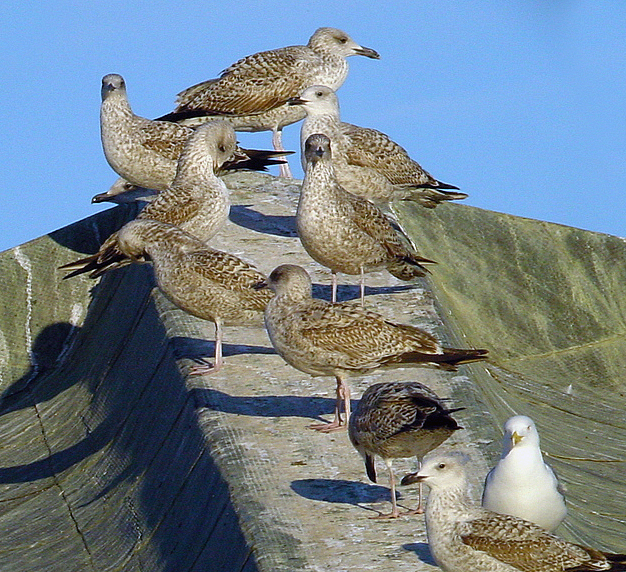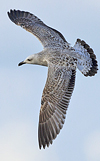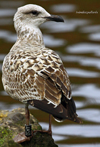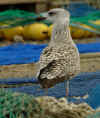 Yellow-legged
Gull - Larus michahellis
Yellow-legged
Gull - Larus michahellis
(last update: October 08 2013)
Coordinators:
Delfín González
Gabriel Martín
Antonio Gutierrez
Amir Ben Dov
Mars Muusse
Larus michahellis - 1CY November

Yellow-legged
Gulls
(L. michahellis) 1CY, November 25 2003, Sète harbour, S France.
This website deals with the Yellow-legged Gull taxon michahellis, which is a common migrant from July to December in NW Europe. After extensive expansion of the breeding population during the last three decades, it nowadays can be found breeding in Belgium, the Netherlands and Britain in mixed couples with both Herring Gull (argenteus) and Lesser Black-backed Gull (graellsii). There are subtle differences between the populations from the Mediterranean, Atlantic coast of Portugal and Morocco and from the islands in the Atlantic. Most pronounced differences can be found in the taxon atlantis, now regarded as full species by some authors and birds along the Atlantic coast of the Iberian peninsular: lusitanius. Both atlantis and lusitanius are treated in their own sections on this website.
General description:
By November, active moult is more or less
suspended with winter starting. Single individuals can be found continuing the
scapular moult at a low pace, finishing the moult in the lowest row of lower
scapulars, while some birds grow the last replaced wing-coverts.
On
some locations in the Netherlands, like landfills and along the coast (like
the Maasvlakte, near the port of Rotterdam) groups of few tens can be found
daily, although the majority of michahellis migrate south by November. Some
1CY michahellis are metal-ringed or colour-ringed and
they originate from southern France (Marseille - Leucate), northern Italy,
Croatia and Switzerland.
Rectrices & remiges moult in November:
The figures of late October suggest that moult
in the rectrices continues in November as well, but we have no substantial samples scored on
this feature yet.
We checked 43 ringed 1CY michahellis at various locations in S.
France late November 2003: 37 showed a complete juvenile tail (86%), in
six birds (14%) the tail was not judged. However, we encountered un-ringed
birds, which had replaced tail-feathers by late November.
In NW France we scored 413 1CY michahellis, between August 21 2002
and February 09 2003: 39 birds (about 10%) showed at least one second
generation tail-feather, in 102 birds (about 25%) the tail-feathers were
not judged.
Rectrices moult seem to correlate with moult in wing-coverts, as we have
no birds completely lacking wing-covert moult together with replaced
tail-feathers. However, one individual had replaced tail-feather(s) and
only limited moult in the coverts (1 greater covert & four lesser
coverts). In general however, birds with second generation tail-feathers
also have substantial moult in the wing-coverts and tertials (majority
scored over 20% of the maximum score for second generation feathers in all
wing-coverts and tertials, and scores of over 40% not uncommon).
We have no indication 1CY michahellis moult secondaries or
primaries in 1CY: so far all birds showed juvenile remiges.
Scapular moult stage and pace in November:
Normally, 1CY michahellis have shed
and replaced the juvenile feathers in the scapulars and mantle feathers.
In turn the mantle and scapulars completely consist of second generation feathers
by late October and early November. By late November, many birds start
subsequent moult wave in the upper scapulars, replacing the second
generation feathers for third generation.
The last moulted second generation lower scapulars show a brownish or buffish based centre with a pattern of dark bars or anchor
pattern. The feathers show a broad white fringe. The new third generation
feathers can show various patterns:
- again very second generation-like with anchor patterns but again with
warm brown centres;
- a grey base with ill-defined anchor pattern close to the tip;
- plain grey feathers with a dark shaft streak.
Complete grey feathers are very rare, but some 1CY November birds tend to
show plain grey, adult-like feathers (e.g. 947X,
ringed 1CY michahellis from S France).
Moult in the scapulars seem to be an
ongoing process right from fledging to late-November. Scapular moult may
continue at a very slow pace during the winter months from December to
March, but the major replacements take place until November. This is
illustrated by the images, which hardly show a bird with obvious moult
gaps in the scapular region.
The extend of this scapular moult is probably strongly influenced by
hedging date, but more research is necessary. November 2003, we checked 43
1CY michahellis in S France, at various locations. About 20% of
these birds had all upper scapulars still second generation, without fresh
third generation feathers. This figure may be higher (up to 33%) as
observation distance was too far in some cases to fully exclude small
third generation upper scapulars at the division of the mantle feathers,
but third generation scapular scores in these birds must have been low
anyway.
About 45% of the 1CY birds in S France had at least moulted some upper
scapulars to third generation (45% of the birds fall in class 1-25%
scapulars moulted to 3rd generation). Most advanced birds showed an almost
completely replaced upper scapular region (2 birds fall in class 75-99% of
upper scapulars third generation) and one of these birds even moulted most
lower scapulars to third generation (class 50-75%). Not surprising
perhaps, this is 947X again.
Tertial & wing-covert moult in November:
By November, some birds still show a complete juvenile wing, with extensive wear in the covert fringes (especially the inner coverts) and juvenile tertial fringes.
We checked 43 ringed 1CY michahellis at various locations in S. France late November 2003: 4 showed no moult in tertials or coverts (9%), and another 4 birds showed limited moult in median, lower lesser coverts and/or lesser coverts, lacking moult in greater coverts and tertials (less 10% of the maximum score). The extend of the tertial and covert moult is probably strongly influenced by hedging date, and in future we hope to link our field data with ringing data.
In NW France we scored 413 1CY michahellis, between August 21 2002 and February 09 2003 in a preliminary research: 76 birds (about 20%) completely postponed the moult in wing-coverts and tertials. 94 birds (about 23%) started this partial moult in the coverts, but only included very limited amount of feathers: 5% or less of the maximum tertial and covert score. However, remember that observations from August do not necessarily reflect the final moult stage. 29 out of these 170 birds (17%) were scored prior to mid-September. Normally, after mid-September, covert moult is not initiated at large scale in 1CY michahellis.
The wing-covert and tertial moult vary to a large extend, with some 1CY birds showing retained juvenile wing-coverts and tertials, while the other far end involve birds with very advanced post-juvenile moult. Some birds have over 50% of the wing-coverts and tertials moulted (e.g. 305L, 977Z, 763Z & 527B). In NW France, during the preliminary researc period, we observed 15 birds with scores over 50% of the maximum score, including birds moulted more than 60% of the coverts and tertials (about 70 new second generation wing-coverts and tertials).
The average 1CY michahellis moult stage by mid November includes the two upper tertials, the 3-4 inner greater coverts, most of the median coverts, slightly less lower lesser coverts and a handful of lesser coverts moulted to second generation. The moult in the lesser and lower lesser coverts is quite random, but often concentrated in the inner half of the tracts. A minority of about 5% of the 1CY birds have moulted some of the rectrices.
Under-parts in November:
Field research on under-parts is pretty
difficult as the differences between first and second generation feathers
on belly and flanks are very subtle. Museum specimen should be
investigated, but it's probably difficult to gather a substantial sample
size.
In general, moult in the under-parts is almost finished by late-November,
leaving 1CY birds with second generation feathers on head, neck, upper
breast, flanks and part of the belly. Moult may still be in progress at
the division of lower flank and belly.
The new feathers can be surprisingly different from the old abraded
juvenile feathers, often showing a grey wash and the fresh second
generation feathers on the head often have fine shaft streaks, most
densely at ear-coverts and crown.
Bare parts in November:
Many field guides illustrate 1CY michahellis (so called 'first winter plumage') with complete black bill and mention
this as one of the identification criteria, together with white head.
Typical 1CY November michahellis may show a black bill and white
head, but many birds do not. By November, the bill turns paler at the
base, often obvious at the lower mandible and the very tip may turn white,
almost translucent in a minority of birds.
The iris is dark brown, but depending on light condition, may appear pale
brown as well. The odd bird has paler iris, tending to almond.
The legs are often eye-catching pale, salmon pink, normally lacking
dark shins.
Tables
Juvenile michahellis: moult score November 06 2001, the Netherlands
|
||||||
| second generation mantle + us + ls | lc | llc | mc | gc | tt | |
| 1. | 100% | old | 8x new | #1-7 new | #1-4 new | #1-3 new |
| 2. | 100% | worn juvenile | ||||
| 3. | 100% | old | old | #1-6 new | #1-3 new | old |
| 4. | 100% | old | 1x new | #1-4 new | #1,2 new | old |
| 5. | 100% | old | old | #1,2 new | #1 new | old |
| 6. | 100% | old | 3x new | old | old | old |
| 7. | 100% | all juvenile | ||||
| 8. | 100% | old | old | #1 new | old | old |
| 9. | 100% | old | old | #1 new | #1 new | old |
Notes: |
||||||
 Yellow-legged Gull michahellis U2CD 1CY, November 24 2012, Ashdod, Israel. Picture: Amir Ben Dov.
Yellow-legged Gull michahellis U2CD 1CY, November 24 2012, Ashdod, Israel. Picture: Amir Ben Dov. Yellow-legged
Gull michahellis 1CY 316November 01 2006, VRSU de Colmenar Viejo, Madrid, Spain. Picture: Delfín González.
Yellow-legged
Gull michahellis 1CY 316November 01 2006, VRSU de Colmenar Viejo, Madrid, Spain. Picture: Delfín González. Yellow-legged
Gull michahellis 1CY 42J August & November 2010, Madrid & Alcazar de San Juan, Spain.
Yellow-legged
Gull michahellis 1CY 42J August & November 2010, Madrid & Alcazar de San Juan, Spain.
 Yellow-legged Gull michahellis 1CY 1G6 November 15 2009, VRSU de Colmenar Viejo, Madrid, Spain. Picture: Delfín González.
Yellow-legged Gull michahellis 1CY 1G6 November 15 2009, VRSU de Colmenar Viejo, Madrid, Spain. Picture: Delfín González. Yellow-legged
Gull michahellis 1CY M015864 November 26 2006, Calais, N France.
Yellow-legged
Gull michahellis 1CY M015864 November 26 2006, Calais, N France.
 Yellow-legged
Gull michahellis 1CY M016635 November 02 2010,
Westkapelle, the
Netherlands. Photo: Ies Meulmeester.
Yellow-legged
Gull michahellis 1CY M016635 November 02 2010,
Westkapelle, the
Netherlands. Photo: Ies Meulmeester.
 Yellow-legged
Gull michahellis 1CY 697B November 27 2003, Montpellier, S France.
Photo Ruud Altenburg.
Yellow-legged
Gull michahellis 1CY 697B November 27 2003, Montpellier, S France.
Photo Ruud Altenburg. Yellow-legged
Gull michahellis 1CY 262D November 2001,
Westkapelle, the
Netherlands. Photo Pim Wolf. Note the 3rd generation-like lower scapulars.
Yellow-legged
Gull michahellis 1CY 262D November 2001,
Westkapelle, the
Netherlands. Photo Pim Wolf. Note the 3rd generation-like lower scapulars.  Yellow-legged
Gull michahellis 1CY 703J November 25 2003, Montpellier, S France.
Photo Ruud Altenburg.
Yellow-legged
Gull michahellis 1CY 703J November 25 2003, Montpellier, S France.
Photo Ruud Altenburg.  Yellow-legged
Gull michahellis 1CY 025K November 27 2003, Port la Nouvelle, S France.
Yellow-legged
Gull michahellis 1CY 025K November 27 2003, Port la Nouvelle, S France.  Yellow-legged
Gull michahellis 1CY 576K November 25 2003, Montpellier, S France.
Photo Ruud Altenburg.
Yellow-legged
Gull michahellis 1CY 576K November 25 2003, Montpellier, S France.
Photo Ruud Altenburg. Yellow-legged
Gull michahellis 1CY 305L November 25 2003, Montpellier, S France.
Photo Ruud Altenburg.
Yellow-legged
Gull michahellis 1CY 305L November 25 2003, Montpellier, S France.
Photo Ruud Altenburg. Yellow-legged
Gull michahellis 1CY 142P November 25 2003, Sète, S France.
Yellow-legged
Gull michahellis 1CY 142P November 25 2003, Sète, S France.  Yellow-legged
Gull michahellis 1CY 379P November 24 2003, Leucate, S France.
Yellow-legged
Gull michahellis 1CY 379P November 24 2003, Leucate, S France. Yellow-legged
Gull michahellis 1CY 617V November 25 2003, Montpellier, S France.
Photo Ruud Altenburg.
Yellow-legged
Gull michahellis 1CY 617V November 25 2003, Montpellier, S France.
Photo Ruud Altenburg. Yellow-legged
Gull michahellis 1CY ?37V November 27 2003, Port la Nouvelle, S France.
Yellow-legged
Gull michahellis 1CY ?37V November 27 2003, Port la Nouvelle, S France.  Yellow-legged
Gull michahellis 1CY 112X November 25 2003, Montpellier, S France.
Photo Ruud Altenburg.
Yellow-legged
Gull michahellis 1CY 112X November 25 2003, Montpellier, S France.
Photo Ruud Altenburg.  Yellow-legged
Gull michahellis 1CY 947X November 26 2003, Port St Louis, S France.
Photo Ruud Altenburg.
Yellow-legged
Gull michahellis 1CY 947X November 26 2003, Port St Louis, S France.
Photo Ruud Altenburg. Yellow-legged
Gull michahellis 1CY 332Z November 15 2002, Scheveningen, the
Netherlands. Present here for 4 months.
Yellow-legged
Gull michahellis 1CY 332Z November 15 2002, Scheveningen, the
Netherlands. Present here for 4 months. Yellow-legged
Gull michahellis 1CY 530Z November 25 2003, Montpellier, S France.
Photo Ruud Altenburg.
Yellow-legged
Gull michahellis 1CY 530Z November 25 2003, Montpellier, S France.
Photo Ruud Altenburg. Yellow-legged
Gull michahellis 1CY INHN November 27 2003, Port la Nouvelle, S France.
Yellow-legged
Gull michahellis 1CY INHN November 27 2003, Port la Nouvelle, S France. Yellow-legged
Gull michahellis 1CY-2CY I233 November 2005 - September 2006, Switzerland. Picture: Stephane Aubry.
Yellow-legged
Gull michahellis 1CY-2CY I233 November 2005 - September 2006, Switzerland. Picture: Stephane Aubry. Yellow--legged Gull michahellis ST3U 1CY, November 16 2016, Katwijk, the Netherlands
Yellow--legged Gull michahellis ST3U 1CY, November 16 2016, Katwijk, the Netherlands Yellow-legged Gull michahellis 1CY S5J9 November 08 2009, Chioggia, Venezia, Italy. Picture: Aldo Tonelli.
Yellow-legged Gull michahellis 1CY S5J9 November 08 2009, Chioggia, Venezia, Italy. Picture: Aldo Tonelli. Yellow-legged Gull lusitanius 1CY AM5D November 05 2013, Gijon, Spain. Photo: Iván Díaz Pallarés.
Yellow-legged Gull lusitanius 1CY AM5D November 05 2013, Gijon, Spain. Photo: Iván Díaz Pallarés. Yellow-legged Gull lusitanius 1CY F226 November 14 2012, Porto, Portugal. Photo: Rui Caratão.
Yellow-legged Gull lusitanius 1CY F226 November 14 2012, Porto, Portugal. Photo: Rui Caratão. Yellow-legged
Gull michahellis 1CY, November 24-26 2006, Etaples / Boulogne-sur-Mer, NW France.
Yellow-legged
Gull michahellis 1CY, November 24-26 2006, Etaples / Boulogne-sur-Mer, NW France. Yellow-legged
Gull michahellis 1CY, November 24-26 2006, Etaples / Boulogne-sur-Mer, NW France.
Yellow-legged
Gull michahellis 1CY, November 24-26 2006, Etaples / Boulogne-sur-Mer, NW France. Yellow-legged
Gull michahellis 1CY, November 24-26 2006, Etaples / Boulogne-sur-Mer, NW France.
Yellow-legged
Gull michahellis 1CY, November 24-26 2006, Etaples / Boulogne-sur-Mer, NW France. AE4F1269 Ashdod dump and penetration ponds 24.11.12.jpg) Yellow-legged
Gull michahellis (?) 1CY, November 24 2012, Ashdod, Israel. Picture: Amir Ben Dov..
Yellow-legged
Gull michahellis (?) 1CY, November 24 2012, Ashdod, Israel. Picture: Amir Ben Dov.. Yellow-legged
Gull michahellis 1CY, November 24-26 2006, Etaples / Boulogne-sur-Mer, NW France.
Yellow-legged
Gull michahellis 1CY, November 24-26 2006, Etaples / Boulogne-sur-Mer, NW France. Yellow-legged
Gull michahellis 1CY, November 24-26 2006, Etaples / Boulogne-sur-Mer, NW France
Yellow-legged
Gull michahellis 1CY, November 24-26 2006, Etaples / Boulogne-sur-Mer, NW France Yellow-legged
Gull michahellis 1CY, November 24-26 2006, Etaples / Boulogne-sur-Mer, NW France.
Yellow-legged
Gull michahellis 1CY, November 24-26 2006, Etaples / Boulogne-sur-Mer, NW France. Yellow-legged
Gull michahellis 1CY, November 24-26 2006, Etaples / Boulogne-sur-Mer, NW France
Yellow-legged
Gull michahellis 1CY, November 24-26 2006, Etaples / Boulogne-sur-Mer, NW France Yellow-legged
Gull michahellis 1CY, November 24-26 2006, Etaples / Boulogne-sur-Mer, NW France.
Yellow-legged
Gull michahellis 1CY, November 24-26 2006, Etaples / Boulogne-sur-Mer, NW France. Yellow-legged
Gull michahellis 1CY, November 24-26 2006, Etaples / Boulogne-sur-Mer, NW France
Yellow-legged
Gull michahellis 1CY, November 24-26 2006, Etaples / Boulogne-sur-Mer, NW France Yellow-legged
Gull michahellis 1CY, November 29 2007, Chevroux, Switzerland. Picture: Stephane Aubry.
Yellow-legged
Gull michahellis 1CY, November 29 2007, Chevroux, Switzerland. Picture: Stephane Aubry. Yellow-legged
Gull michahellis 1CY, November 13 2009, Westkapelle, the Netherlands.
Yellow-legged
Gull michahellis 1CY, November 13 2009, Westkapelle, the Netherlands. Yellow-legged
Gull michahellis 1CY, November 22 2003, Banyuls/Mer, S France. Average moult in coverts.
Compare to 2CY plumage.
Yellow-legged
Gull michahellis 1CY, November 22 2003, Banyuls/Mer, S France. Average moult in coverts.
Compare to 2CY plumage. Yellow-legged
Gull michahellis 1CY, November 22 2003, Banyuls/Mer, S France.
Yellow-legged
Gull michahellis 1CY, November 22 2003, Banyuls/Mer, S France.  Yellow-legged
Gull michahellis 1CY, November 22 2003, Rosas, NE Spain. Average moult in coverts.
Yellow-legged
Gull michahellis 1CY, November 22 2003, Rosas, NE Spain. Average moult in coverts. Yellow-legged
Gull michahellis 1CY, November 22 2003, Rosas, NE Spain. Average moult in coverts.
Yellow-legged
Gull michahellis 1CY, November 22 2003, Rosas, NE Spain. Average moult in coverts. Yellow-legged
Gull michahellis 1CY, November 22 2003, Rosas, NE Spain. No moult in coverts.
Yellow-legged
Gull michahellis 1CY, November 22 2003, Rosas, NE Spain. No moult in coverts. Yellow-legged
Gull michahellis 1CY, November 22 2003, Rosas, NE Spain. Slightly
more than average moult in coverts.
Yellow-legged
Gull michahellis 1CY, November 22 2003, Rosas, NE Spain. Slightly
more than average moult in coverts. Yellow-legged
Gull michahellis 1CY, November 22 2003, Rosas, NE Spain. Two
birds with limited moult in coverts.
Yellow-legged
Gull michahellis 1CY, November 22 2003, Rosas, NE Spain. Two
birds with limited moult in coverts. Yellow-legged
Gull michahellis 1CY, November 22 2003, Rosas, NE Spain. Average moult in coverts.
Yellow-legged
Gull michahellis 1CY, November 22 2003, Rosas, NE Spain. Average moult in coverts. Yellow-legged
Gull michahellis 1CY, November 15 2003, Westkapelle, the Netherlands (51.33N, 3.25E).
Yellow-legged
Gull michahellis 1CY, November 15 2003, Westkapelle, the Netherlands (51.33N, 3.25E).  Yellow-legged
Gull michahellis 1CY, November 22 2003, Rosas, NE Spain. Extensive moult in coverts.
Yellow-legged
Gull michahellis 1CY, November 22 2003, Rosas, NE Spain. Extensive moult in coverts.